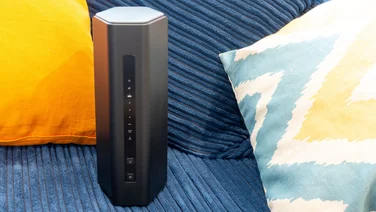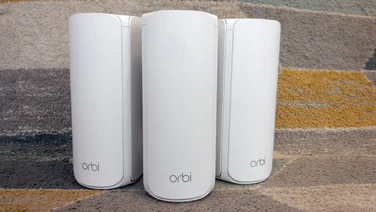To help us provide you with free impartial advice, we may earn a commission if you buy through links on our site. Learn more
- We have years of experience testing Wi-Fi extenders, and we subject all the products we review to the same series of real-world tests
- We evaluate Wi-Fi extenders mainly on speed, but ease of setup also plays a part in the overall score
- Our favourite current Wi-Fi extender is the TP-Link RE300. It’s only basic, but it’s cheap, very easy to use and effective
- If you need a more belt-and-braces approach to extending your Wi-Fi network, we recommend the Devolo Magic 2 Wi-Fi 6 Whole Home kit. It’s expensive, but gives you solid coverage in even the most challenging domestic environments

If all you want is a quick way to extend Wi-Fi coverage into the spare room you don’t have to spend the Earth on exotic hardware. That’s why our favourite extender is still the venerable TP-Link RE 300. It’s only Wi-Fi 5 but at less than £30, this discreet little box ticks all the boxes.
If you want the very best extender with the longest reach and best speed however, look a little lower in our list, where we have choices that stretch your Wi-Fi network far beyond the limits of your existing wireless network.
If you want to find out more about Wi-Fi extenders and what makes them tick, click through to our buying guide here. Otherwise, read on for our recommended options.
Best Wi-Fi extenders, at a glance:
- TP-Link RE300: Best budget extender | Check price at Amazon
- TP-Link RE650: Best Wi-Fi 5 extender | Check price at Amazon
- TP-Link RE505X: Best Wi-Fi 6 extender | Check price at Amazon
How we test Wi-Fi extenders
Every Wi-Fi extender we review goes through extensive hands-on testing. Each unit is installed in a real home, at an appropriate distance from the main Wi-Fi router according to the manufacturer’s recommendations. If it’s a powerline system, we connect the base unit to the main router via gigabit Ethernet and, again, situate the remote unit according to the instructions.
We then work through the setup process, allowing the extender to connect to the existing home network and apply its default settings. We’re looking for how quick and easy this is, and whether it picks the best configuration for optimal performance.
To test network performance, here are the steps we take:
- We use a laptop equipped with an Intel Wi-Fi 6 network card supporting 2×2 MIMO
- We connect this laptop to the extended network, then take it to various areas of the home and copy a standard set of files to and from a NAS (network attached storage) appliance, which is connected by Ethernet to the main router
- By measuring the average read and write speeds, and comparing them to those achieved when connecting directly to the router, we can measure how each extender helps Wi-Fi range and performance
If the extender has advanced features, we’ll also factor these into our review; we’ll thoroughly explore the configuration portal, whether that’s app- or web-based, to see how responsive and user-friendly it is, and, if the unit has an Ethernet port, we test network performance over a wired connection as well.
The best Wi-Fi extenders you can buy in 2025
1. TP-Link RE300: Best budget Wi-Fi extender
Price when reviewed: £33 | Check price at Amazon

- Great for… solid range extension at a budget price
- Not so great for… high-performance speeds
TP-Link’s RE300 is basic, but it’s incredibly easy to set up via the TP-Link Tether app and it comes with a couple of extra modes to help you make the most of your current wireless network. We found it worked best in default mode, where speeds averaged 11.3MB/sec in testing. If you’re a tinkerer, however, you can also set it up so it uses the faster 5GHz band as a dedicated link to your existing network and the 2.4GHz band for your devices.
Either way, the RE300 works really well. Speeds were quick and connectivity reliable, plus it doesn’t take up too much space in your plug sockets, leaving plenty of room for other devices to use the sockets next to it. The only thing it lacks is an Ethernet port, but this compact unit offers solid performance for not a lot of money.
Key specs – Radio bands (maximum speed): 2.4GHz (300Mbits/sec), 2 x 5GHz (866Mbits/sec); Ethernet ports: None; WPS button: Yes
2. TP-Link RE505X: Best Wi-Fi 6 extender
Price when reviewed: £50 | Check price at Amazon

- Great for… Wi-Fi 6 networks, especially those with a TP-Link router
- Not so great for… anyone with a Deco mesh device
If you’ve invested in a Wi-Fi 6 router, then you may find you’ve already got great speeds and a rock-solid connection all around your house. But if you need to stretch it a little further, you won’t do much better than the TP-Link RE505X. On paper, its speeds aren’t amazing: with 1,200MBits/sec on the 5GHz band and 300Mbits/sec over 2.4GHz, there are faster Wi-Fi 5 extenders out there. In practice, however, the RE505x delivers a fast, stable connection in places where older extenders and mesh systems struggle, delivering downstream speeds of over 50MB/sec and even supporting demanding applications like Steam Link game streaming from a desktop PC.
As a bonus, if you have a TP-Link router that supports its OneMesh technology, you get hassle-free, seamless connectivity wherever you are in your home. Needless to say, you need a Wi-Fi 6 router and compatible devices to make the most of it, but this extender gives you the latest wireless tech at a bargain price.
Read our full TP-Link RE505X review
Key specs – Radio bands (maximum speed): 2.4GHz (300Mbits/sec), 5GHz (1,200Mbits/sec); Ethernet ports: 1 x Gigabit; WPS button: Yes
3. Devolo Magic 2 Wi-Fi 6: Best powerline and Wi-Fi extender
Price when reviewed: £380 (whole home kit) | Check price at Amazon

- Great for… solid performance in the most awkward environments
- Not so great for… modern homes with thin walls
Devolo’s Magic 2 WiFi 6 straddles the world of wireless extenders, powerline and mesh Wi-Fi and offers an effective alternative to traditional wireless network hardware. By combining fast 2,400Mbits/sec G.Hn powerline with dual-band 802.11ax Wi-Fi, it delivers the best of all worlds: solid connectivity, even to tricky-to-reach places, and impressive top speeds.
It’s the fastest powerline system we’ve tested. We were staggered to see download speeds in our kitchen test location zoom from just 13Mbits/sec to 29Mbits/sec. That’s an astonishing leap, but bear in mind that a lot will depend on the layout and quality of your home’s wiring.
For homes with thick walls, unusual layouts or long gaps between rooms, nothing beats the Devolo Magic 2 Wi-Fi 6 at eliminating notspots. The price is high, but nothing beats it for long-range speed and reliability.
Read our full Devolo Magic 2 Wi-Fi 6 review
Key specs – Maximum Wi-Fi speeds: 1,800Mbits/sec; Powerline speed: 2,400Mbits/sec; Ethernet ports: 2 x Gigabit per unit; WPS button: Yes; Other features: Mains passthrough
4. TP-Link RE700X: Best high performance Wi-Fi 6 extender
Price when reviewed: £63 | Check price at Amazon

- Great for… great Wi-Fi 6 performance, discreet style
- Not so great for… those on a budget
The bigger brother of the lovable RE505X is another compact, plug-in Wi-Fi 6 extender, but with the speeds boosted to meet the AX3000 spec. Similar to its cheaper sibling, this model is easy to set up and configure using TP-Link’s Tether app, and it supports OneMesh technology for seamless roaming around the house. If you have a compatible TP-Link router, it can even set up the RE700X while in this mode.
We like the discreet style, with no sticky-out antennae, but the RE700X’s biggest strength is its excellent performance. It’s the second-fastest Wi-Fi 6 unit we’ve tested, creeping ahead of the Devolo Wi-Fi 6 Repeater 3000, and coming in only just behind the faster Wi-Fi 6 Repeater 5400. In our hard-to-reach kitchen, it hit download speeds of 361Mbits/sec to the Devolo’s 382Mbits/sec. In the upstairs office, the gap was wider at 263Mbits/sec against 334Mbits/sec; but that’s still a fantastic effort.
The RE700X is more expensive than the RE505X, but if you have an AX3000 or AX5400 router, we’d say it’s worth it. What’s more, we’ve seen some great deals on this one, with prices dropping as low as £55.
Key specs – Radio bands (maximum speed): 2.4GHz (574Mbits/sec), 5GHz (2.4Gbits/sec); Ethernet ports: 1 x Gigabit; WPS button: Yes
5. TP-Link RE815XE: Best Wi-Fi 6E extender
Price when reviewed: £120 | Check price at Amazon

- Great for… super-fast networking with a Wi-Fi 6E router
- Not so great for…use without a Wi-Fi 6E router
This is first Wi-Fi 6E extender we’ve tested, and it delivers spectacularly good performance when paired with a Wi-Fi 6E router. It reached speeds of 70MB/sec in my kitchen where my previous best result was 47.7MB/sec. And there were improvements in my office, too, where the mighty Devolo Wi-Fi 6 Repeater 5400 provides downstream speeds of 41.82MB/sec. The RE815XE boosted that to 57.5MB/sec.
The big caveat here is that you won’t see the best from TP-Link’s extender unless you also have a Wi-Fi 6E router. Wi-Fi 6 devices will still get improved performance, thanks to the use of the 6GHz band as a backhaul, but without a Wi-Fi 6E router that advantage disappears.
What’s more, it’s expensive and more power-hungry than other extenders, consuming up to 7.1W in our tests. And, if you’re worried about looks, the RE815XE is something of a beast, with four big antennae sticking out of a chunky 80 x 154 x 30mm box. This extender is great value, then, if you’ve already jumped on the Wi-Fi 6E bandwagon, but without that you’re better off looking at other options on this page.
Key specs – Radio bands (maximum speed): 2.4GHz (574Mbits/sec), 5GHz (2,402Mbits/sec), 6GHz (2,402 Mbits/sec); Ethernet ports: 1x Gigabit; WPS button: Yes
6. Devolo Wi-Fi 6 Repeater 5400: Best money-no object Wi-Fi 6 extender for speed
Price when reviewed: £130 | Check price at Amazon

- Great for… anyone needing serious speed
- Not so great for… devoted minimalists
The WiFi 6 Repeater 5400 is a serious speed demon, matching the AX5400 spec with up to 4.8Gbits/sec on the 5GHz band and up to 574Mbits/sec on the 2.4GHz band. In our tests, it was the fastest extender we’ve reviewed in this particular house, with speeds of 334Mbits/sec download and 228Mbit/sec upload in rooms where Devolo’s own Wi-Fi 6 Repeater 3000 could only give us 231Mbits/sec and 138.4Mbits/sec, respectively.
The downside of these speeds is that they involve a design that looks more like a small router with a separate power supply. However, this gives you more flexibility than a plug-in unit, helping you to get a better signal, while you can also use this repeater as a Wi-Fi access point. And, just like the Repeater 3000, it’s as simple as anything to set up. The Wi-Fi 6 Repeater 5400 will be overkill for many people, but if you must get a high-speed connection to a distant corner of the house, nothing else out there comes close.
Read our full Devolo Wi-Fi 6 Repeater 5400 review
Key specs – Radio bands (maximum speed): 2.4GHz (574Mbits/sec), 5GHz (4.8Gbits/sec); Ethernet ports: 2x Gigabit; WPS button: Yes
How to choose the best Wi-Fi extender for you
Is a Wi-Fi extender definitely the answer?
Before you buy an extender, check that it really is the performance of your wireless network that’s slowing you down and not just a slow internet connection. You can use a broadband speed checker to measure download speeds at different distances from your router, and see how the speed drops off as you move around your home.
It’s also worth trying out a few different wireless settings, such as switching radio bands, before you splash out on a new bit of kit. You might find that this gets you a better signal from your existing equipment and that there’s no need to buy an extender at all.
What speeds can I expect?
Some extenders promise data rates as high as 4.8Gbits/sec, which is equivalent to around 600MB/sec and far faster than most broadband connections. In reality, for all sorts of technical and practical reasons, the speeds you see in your own home will be far, far lower, with much of the bandwidth lost in the connection between the extender and the router, let alone the connection between the extender and your laptop or devices.
As a rule, we’re happy with anything over 120Mbits/sec (15MB/sec). To put that into context, Netflix recommends a connection speed of at least 5Mbits/sec for HD streaming and 25Mbits/sec for 4K video. A good, solid Wi-Fi network should easily be fast enough to cope with multiple simultaneous high-resolution video streams.
Up until recently, most extenders and Powerline kits only went as far as the Wi-Fi 5 standard, but we’re seeing a growing number that go faster with Wi-Fi 6 support. If you only have a Wi-Fi 5 router, you can save some cash by partnering it with a Wi-Fi 5 extender, but the newer models may give you a faster connection between the extender and devices that support Wi-Fi 6. What’s more, there’s an argument that buying one of these makes more sense if you plan to upgrade your network in the future.
What’s the difference between a repeater and a powerline extender?
These are the two main types of extender and they do the same basic job. However, they work in different ways. A Wi-Fi repeater is a single box that relays data back and forth between your router and your wireless devices using Wi-Fi signals alone. If – for example – your router is located at the front of the house, and your home office is at the rear, you can install a repeater at the midway point to boost the signal in the office.
A powerline networking kit consists of two little boxes (sometimes more) that plug into mains sockets around your home. Box number one connects to your router via an Ethernet cable, while box number two broadcasts a wireless signal from wherever it happens to be situated and relays the data back to the first box over your mains electrical wiring.
Powerline systems are often more expensive than repeaters but they’re a fuss-free way to extend a network connection into places that are otherwise hard to reach and can be simpler to set up.
Might I be better off with a mesh Wi-Fi system?
Mesh networking systems work in a similar way to Wi-Fi repeaters but they give you the option of placing multiple nodes all over your home to cover a larger area than a single extender could manage. You can learn more, and explore our recommended models, in our guide to the best mesh Wi-Fi routers.
If you don’t have a huge house, however, a mesh system may be overkill. A regular extender is a lot cheaper and a lot easier to install. Configuring a mesh system normally involves setting up a whole new router, whereas with most repeaters you can simply plug it in, press a button and that’s it.
Does my extender need Ethernet sockets?
In this wireless age, Ethernet sockets might seem a bit outdated. But some devices, such as printers and set-top TV boxes, only support wired connections, and connecting these or a PC to your extender via Ethernet will give you a more reliable and often faster connection than wireless.
Naturally, however, connecting devices to an extender via Ethernet won’t be as fast as a direct wired connection to the router because the signal still needs to travel from your router to the extender over the airwaves first.
What other features should I look for?
Most Wi-Fi extenders have what’s called a “web portal”, which offers a selection of advanced features (some offer a mobile app as well). This is accessed via a web browser, either on your phone or your laptop. Simply type in the address provided by the manufacturer – which is often printed on the extender itself or, failing that, it will be in the manual somewhere.
Some of these web portals will let you operate a guest network, with its own name and security settings, so visitors can connect to the internet without having access to your local devices. You might also get access controls, which let you decide exactly who can connect, while scheduling lets you shut off the connection at certain times – useful, perhaps, if you don’t want kids going online in the middle of the night.
Think about physical features when choosing your extender. Most units plug directly into a mains socket, and some models are so big that they block neighbouring outlets from use. A mains passthrough socket on the front can also be very useful if you’re running low on mains sockets and this certainly isn’t something you can take for granted.












